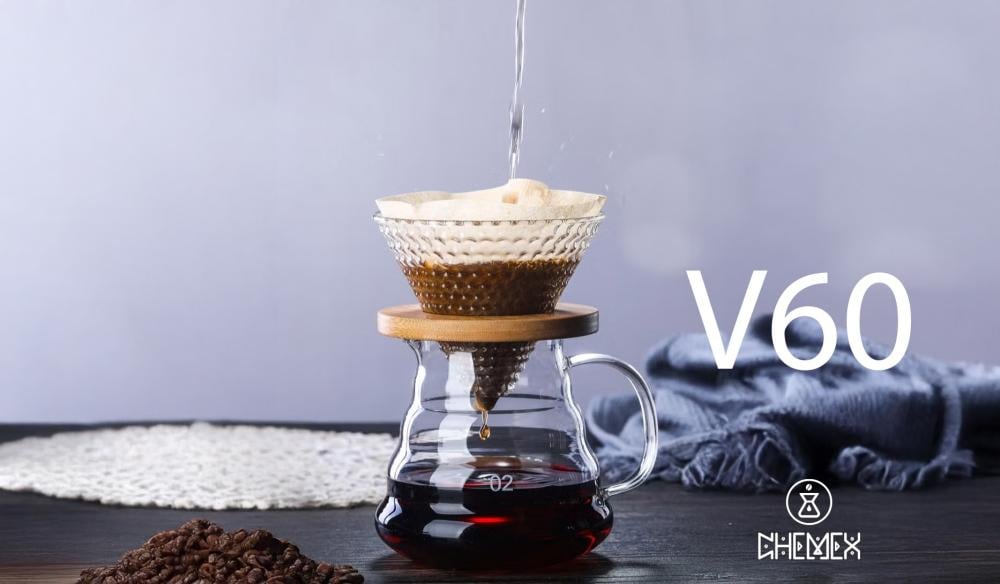The V60 is a manual pour-over dripper renowned in the specialty coffee world for its ability to bring out the subtle flavors of coffee by adjusting water flow and time. It uses a conical filter paper and a special internal structure that allows air to pass through and aids in consistent extraction.
The name “V60” comes from the cone shape (V) and the 60-degree angle on its sides that are designed to help ensure optimal water flow through the coffee.
The inventor and the beginnings of the idea
The Japanese company Hario is the inventor of the V60 machine. Founded in Tokyo in 1921 by Hiromu Shibata, the company specialized in the manufacture of heat-resistant glass and physical and chemical laboratory products.
Hario began entering the coffee maker market in the mid-20th century. For example, in the late 1940s, it introduced the first glass-based Syphon home brewer. In 1980, Hario launched the "Mini Coffee Dripper" as its first attempt at a simple conical filter—but it wasn't widely popular at the time.
In the early 2000s, the company revived the idea of the conical strainer and began developing the version that would become the V60 today. In October 2005, the commercial version was officially launched after the team spent time designing, testing, and tweaking. The new design included internal spiral ribs to allow air to escape and prevent paper from sticking, and a large opening at the bottom of the cone to control water flow.
Technical development over time
Since the launch of the V60, Hario has developed several versions and construction materials: ceramic, heat-resistant glass, plastic, and even metal. Some models feature improved internal ribs or flow distribution for ease of use. Improvements have also been made to accompanying designs, such as the gooseneck kettle and scale/timer to complement the experience.
In recent years, innovations in pouring techniques have emerged, such as the "4:6" method invented by barista Tetsu Kasuya, which distributes water in stages to control flavor. Competition has also prompted other companies to develop competing tools (such as the Kalita Wave) or design changes to deliver similar or alternative results.
Marketing and Outreach Strategies
The V60's success was no coincidence; both marketing and technical factors helped:
- Online communities and niche blogs
- Since early 2008, coffee blogs (such as Barismo) have been discussing the V60, sharing experiences and techniques, and spreading the concept from Japan to the US and Europe. Forums, YouTube, and coffee websites have been powerful platforms for dissemination.
- Accreditation in international coffee competitions
- The V60 has achieved great popularity in World Brewers Cup competitions, with competitors winning it several years in a row. Winning these competitions has given baristas and coffee shops a boost of credibility.
- Highlighting the quality of results and control
- Marketing emphasized that the V60 gives users precise control over extraction (pouring speed, water distribution) to achieve a pure, flavorful cup. This appealed to specialty coffee enthusiasts who value experimentation and control.
- Complete system integration for home coffee
- Hario has expanded the brand to include supporting tools such as a pitcher, scales, and filters, ensuring that anyone who buys a V60 with the included accessories will have everything they need within a complete system.
- Global expansion and distribution
- Hario began distributing its products to specialty coffee markets in America and Europe, partnering with local distributors and listing them in specialty coffee shops. With the growing demand for manual coffee machines, the V60 became widely available.
How did it take over the market?
- Identity in the coffee community : The V60 has become a specialty coffee icon—using it means you're a connoisseur or at least really care about coffee.
- Competition Success as Credibility : The V60's multiple competition wins have proven its capabilities in practice to a keen audience.
- Encouraging education and free content : The proliferation of YouTube tutorials and blogs has made it possible for anyone with the ability to learn the perfect pouring technique, lowering the barrier to entry for beginners.
- Natural progression of accessories : After a user purchases a V60, they often need special filters, a suitable pitcher, and scales, all of which creates a rapidly growing market for related accessories.
- Value for money : Compared to complex commercial coffee machines, the V60 is a relatively simple and less expensive option with the potential for high quality, which makes it attractive to many consumers.
- Adapt to local coffee cultures : In each market we have entered, we have adapted our marketing approach (workshops, café demonstrations, partnerships with local roasters) to make it closer to the local consumer.

